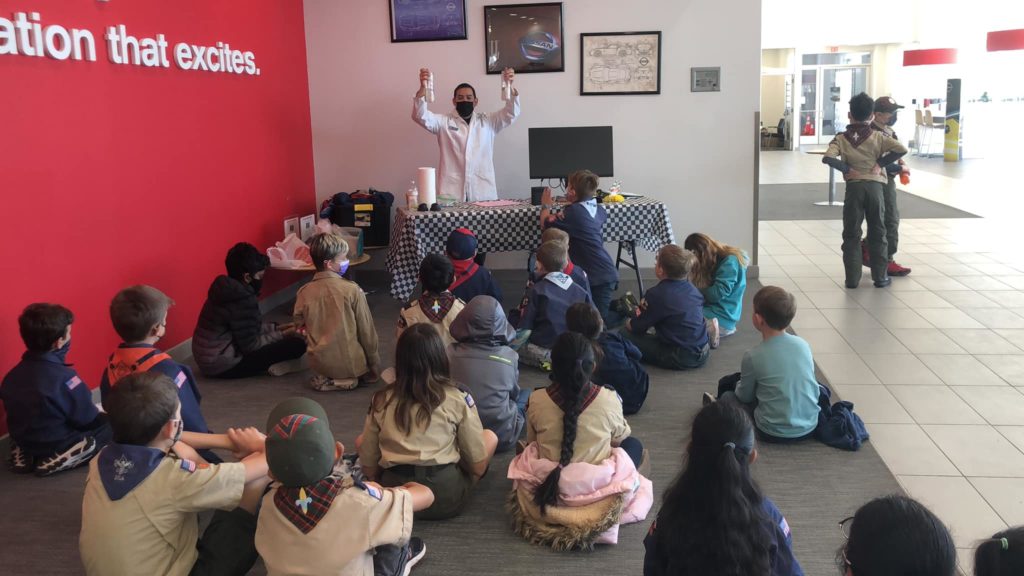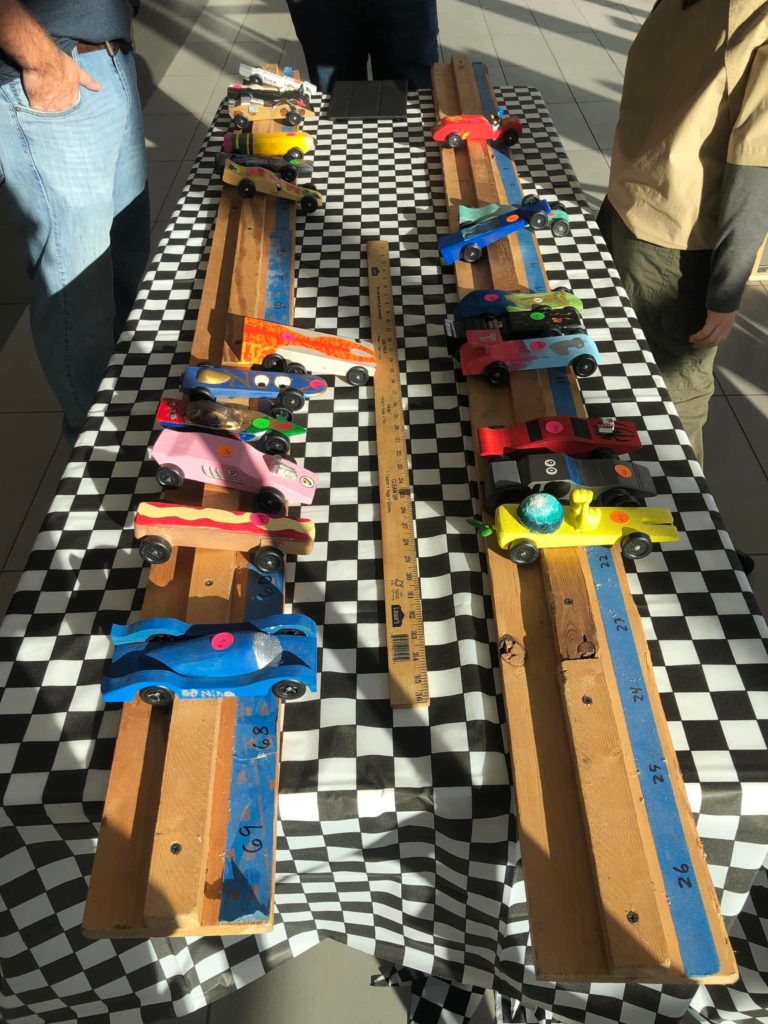It was a Saturday in January here in Central Texas and the weather was beautiful. Pack 170 Scouts and families had spent the past several weeks building and tuning their Pinewood Derby cars. That day, January 29th, was the day that all of that effort would payoff. But this Pinewood Derby would be different. It would be our first STEMwood Derby. And, Cedar Park Nissan once again cleared their showroom floor to showcase the event.

Dustin Krieger, General Manager
Partnering with local business Cedar Park Nissan was a great experience. General Manager Dustin Krieger presented awards, managed the lane timers, and acted as starter. In addition it strengthened ties between Scouting and the community.
Pinewood Derbies are fertile ground for STEM, as you can see from the STEM facts in the Lego Derby article from last July. The tuning that some Scouts and families do on their cars is all about science and engineering. The car design… science and engineering and math. The track is a small engineering marvel. Technology is rampant in Pinewood Derby from the electronic timers to the software, to the computers, and, let’s not forget the internet where the software may be hosted and for streaming the event, the large flatscreen TVs displaying race lineups and results.


So this year, our annual Pinewood Derby became an active and engaging NOVA classroom in our first-ever STEMwood Derby, and it was a big hit with the Scouts and their families. Instead of running den heats, we ran mixed heats with Scouts and families mixed together. We ran 3 sets of 9 heats each. No one knew their den or pack standings until the very end so the excitement was there for everyone the whole time.
After each set, STEM coordinator, Mr. Cris, held an “Up and Away” NOVA classroom for the Scouts with videos and experiments, discussion and, of course, learning. While they were busy with NOVA, the leaders were getting ready for the next heats.
“I don’t think we’ve ever learned this much at a pinewood derby before.”
“So when a skydiver opens their parachute, they slow down because they have more area – and more drag!”
- It is hard to keep the kids engaged for the whole time, so we would lose scouts as the event went on.
- The pack has a 6 lane track, so each car runs 6 heats, one in each lane. Dens with less than 6 racers had empty lanes, wasting valuable time.
- Finally, when running by Den, it was obvious which cars were the fastest.
In 1687 Isaac Newton published “Principia” – and in doing so, shaped the future of humankind. In these books, he defined the universal laws of motion and gravity. 335 years later we now live in a world of powered human flight and streamlined engineering for high-performing vehicles.
STEM Fact
Our understanding of gravity and unbalanced forces help us to understand and test effects of MASS, AREA, DENSITY, GRAVITY, DRAG, and FRICTION on several different types of cars and planes. Our pinewood derby cars can maximize terminal velocity by reducing drag and cross-sectional area. We can also use math to determine where the mass from our vehicle should be centered to give us the most potential energy to use to power us to the finish line. During our Pinewood Derby, we saw first hand how our fastest cars applied this math to their designs.
STEM Fact
Newton’s laws are universal. That means we can apply the same math to other planets as well. In 2021, NASA’s Perseverance Rover was able to land successfully on Mars because our scientists understood these concepts on Earth and adjusted for the differences in Gravity and Air Density on Mars. Knowing an object’s TERMINAL VELOCITY means that these scientists could predict the right time to deploy parachutes or other thrusters to counter the downward force during the rover’s entry.
STEM Fact
While completing UP & AWAY Nova between PWD heats, we demonstrated terminal velocity by showing how objects of different masses fell at different speeds through corn syrup. We observed that while these marbles and steel ball bearings had the same cross-sectional area and drag coefficients (they were spheres of the same size), higher MASS increased the steel ball bearing’s velocity through the syrup. We also saw that a larger marble moved faster than a smaller marble – despite a larger cross-sectional area. Why? It’s mass was also greater.
STEM Fact
Corn syrup is similar to the air on Earth. It is a fluid that an object can fall through. Another example of a fluid is water. And if you were to drop either a steel ball bearing or a marble into water, you would see that they would drop much more quickly through water. That’s because corn syrup is MORE DENSE than water. And the same is true for air on Earth and Mars. Air is MUCH MORE dense on Earth than on Mars, so an object of the same mass and area will be able to fall at greater speed on Mars, even if the force of gravity on Mars is a little bit weaker.
“But gravity is greater on Earth, so shouldn’t it fall faster on Earth?”

